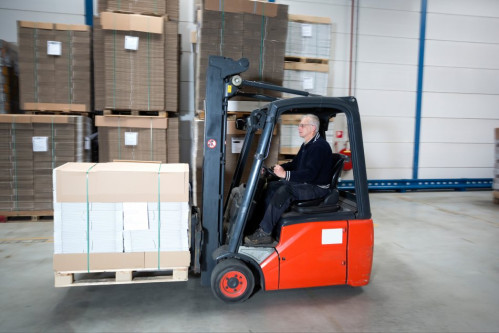What authorizations and documents do you need to operate a forklift yourself?
The only palletised goods handling machines that do not require a licence to operate are simple hand pallet trucks. All other pallet trucks and internal combustion or electric forklifts require the operator to obtain the appropriate licence. This requires training and passing a state exam.

Who can get a licence to operate forklift trucks?
In order to take the forklift operator training and examination, you must be at least 18 years old and (at least) have completed primary school. You will also need a standard medical certificate from an occupational doctor stating that there are no contraindications to working as a forklift operator (this is how various types of forklifts are referred to collectively in official nomenclature). In principle, the only contraindications are serious visual and hearing impairments: the forklift operator must be able to judge distances accurately and hear audible warning signals, the sounds of work and the presence of other people and machines in the working environment. Some mobility dysfunctions (the operator should be very physically fit) and illnesses associated with temporary loss of body control (primarily illnesses causing epileptic seizures) can also be strong contraindications to forklift operation.
If the candidate meets the conditions listed, he or she can take advantage of offers from one of the many training companies that run courses to prepare for the state exam. This is currently the only way to obtain a forklift licence. For many years, it was possible to use an employer-issued licence, which only allowed legal operation within a single workplace. Nowadays, every operator has to pass a state examination before a UDT commission for a specific type of forklift truck:
- WJO category III - applies to walk-behind forklift trucks, which means that the operator does not move together with the forklift truck (in a standing or sitting position), but beside it, controlling the machine using the drawbar,
- WJO category II - includes all forklift trucks and pallet trucks where the operator uses a platform or seat placed on the truck and trucks covered by WJO category III,
- WJO category I - allows the use of trucks from WJO category III and WJO category II, as well as so-called specialised trucks, which include, for example, telescopic handlers, reach trucks and trucks in which the operator is lifted in the cabin (basket) with the load.
What are the responsibilities of the forklift owner?
If we are forklift owners, it is incumbent on us to register the forklift and perform annual UDT inspections, as well as diligently performing and documenting the inspections.
After the technical inspection, the Technical Inspection Authority issues a decision to authorise (or not to authorise) the forklift truck for use. The mechanical systems (especially mast, forks, chains), hydraulic system (cylinders, valves, hydraulic lines), electrical circuits and tyres are checked first. The forklift must also have complete documentation confirming its performance, origin and history of previous technical acceptance. If the technical condition assessment is negative, the forklift owner is obliged to stop using the forklift until the appropriate repairs have been made and the technical acceptance has been re-examined by the UDT inspector.
The easiest way to avoid all these procedures is to forgo the purchase of a machine and take advantage of the possibility of renting forklifts and pallet trucks. Having the relevant qualifications is the only condition for using the forklift if it is a rental machine - the other formalities are taken care of by the rental company.